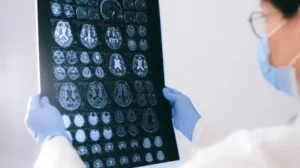Scientists are Unraveling the Cause Behind Sudden Unexpected Death in Epilepsy
Article published by Medical Xpress
Featuring work by CURE Epilepsy grantee, Dr. Edward Glasscock
SUDEP (sudden unexpected death in epilepsy) is a rare consequence of epilepsy, occurring in one in 1,000 people with epilepsy and resulting in an estimated 3,000 deaths per year in the United States. More than a decade of research has pointed to a connection between the brain, lung, and heart, but finding the underlying biological mechanism(s) has remained elusive. Dr. Edward Glasscock and Southern Methodist University (SMU) colleagues recently led a study identifying neurons in regions of the brain that govern everything from emotions to heart rate that may underlie SUDEP.
What scientists have been able to piece together comes from animal studies, particularly from a type of mouse genetically modified to lack a gene called Kcna1. That gene encodes the protein Kv1.1, which helps regulate electrical activity by controlling the flow of potassium in and out of neurons. Mice lacking Kv1.1 had seizures and problems with breathing and heart function. In the case of one mouse, researchers observed a full SUDEP event, with breathing issues followed by heart failure, which matched patterns previously seen in humans. “Catching that was really rare because we only do those recordings with respiration for somewhere between six and eight hours at a time,” Kelsey Paulhus, PhD, the study’s first author and a postdoctoral researcher at SMU, said. “I feel very fortunate that … we were able to catch that because it’s really important information.”
When mapping out the electrical activity in the brain, researchers found that excitatory neurons in a specific brain network called the corticolimbic system were setting off the SUDEP chain reaction. Their hypothesis is that during SUDEP, the corticolimbic system influences the autonomic nervous system, the network of nerves that handle unconscious bodily tasks like heartbeat and breathing. “We know through different experiments that if you manipulate the corticolimbic system, that can affect heart and lung function,” said Paulhus. “We also know that it has direct communication with the brainstem, so that was a really important aspect as to why we homed in there.”
Paulhus and Glasscock hope to expand their findings to uncover biomarkers that identify where communication between the brain, heart and lungs goes awry in their epilepsy models. Such biomarkers could one day help those with epilepsy and their families better manage and navigate the medical condition, hopefully without fear of SUDEP. “One of the things I would love to emphasize is that the most brilliant minds are devoted to trying to figure this out,” Paulhus said. “There are so many people so devoted to this and trying to take huge steps. I think with the speed research goes, we as a field can make some really significant progress.”




